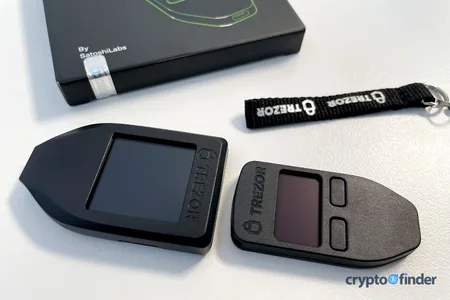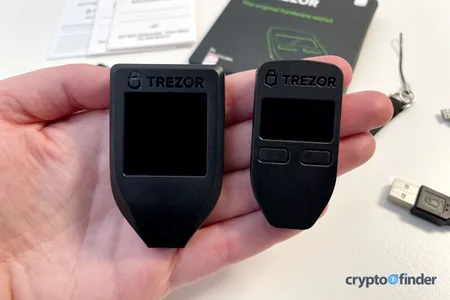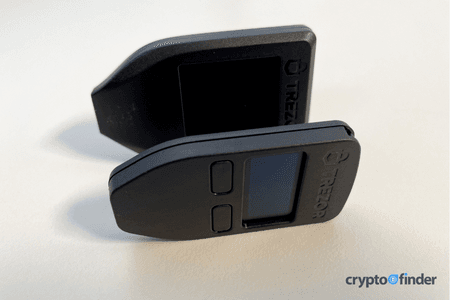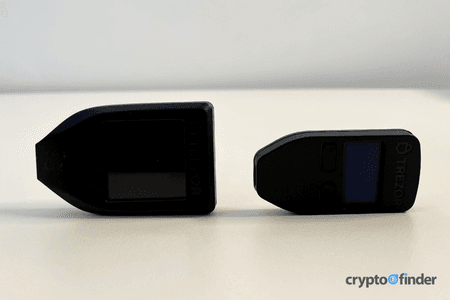
Winner: Trezor Model T
The Model T has a touchscreen, while the Model One doesn't.
Trezor brought the first-ever crypto hardware wallet – the Model One – to market in 2014 and has since been one of the most trusted names in crypto hardware wallets.
The Czech Republic-based company made waves in the crypto space in 2018 again when it released the first-ever crypto hardware wallet with a touchscreen – the Model T.
Trezor still produces both of these models along with the Trezor Safe 5 and Trezor Safe 3, and while they have a number of features in common, they also have a few notable ones aside from the touchscreen that set them apart.
The big question to consider in choosing whether to purchase a Model T or a Model One is whether it's worth paying US$129 for the Model T as opposed to US$59 for the Model One.


| Trezor Model T | Trezor Model One | |
|---|---|---|
 Finder score
★★★★★ |  Finder score
★★★★★ | |
| Dimensions | 64 x 39 x 10mm | 60 x 30 x 6mm |
| Display | 240×240px LCD touch screen | 128×64px OLED screen |
| Security mechanism | ARM Cortex-M4 embedded-arm processor @ 168Mhz | ARM Cortex-M3 embedded-arm processor @ 120Mhz |
| Security certifications | CE and RoHS certified (consumer safety, health and environmental health award | CE and RoHS certified (consumer safety, health and environmental health award |
| Connection | USB-C to USB-A (for mobile), WebUSB | USB-A, WebUSB, Micro USB (for mobile) |
| Compatibility | PC (Windows 10+, macOS 10.11+ and Linux), Mobile (Android) | PC (Windows 10+, macOS 10.11+ and Linux), Mobile (Android) |
| Backup | 12-24-word seed phrase | 12-24-word seed phrase |
| Coin support | 1,000+ | 9,000+ |
| Staking | Yes, but only when linked to third-party wallets | Yes, but only when linked to third-party wallets |
| NFT management capability | ✅ | ✅ |
| Exchange built in to native software (Trezor Suite) | ✅ | ✅ |
| Price (USD) | $129 | $59 |
| Buy the Trezor Model T | Buy the Trezor Model One |
| Trezor Model T | Trezor Model One | |
|---|---|---|
| Connection | USB-A to USB-C (for desktop); USB-C to USB-C (for mobile) | micro-USB (type B) to USB-A (for desktop); micro-USB (type B) to micro-USB (type B) (for mobile) or USB-C (for mobile) |
| Feel/appearance | Plastic casing; lightweight; shaped like a rectangle with a triangle below it (and larger than Model One); touchscreen | Plastic casing; lightweight; shaped like a rectangle with a triangle below it; 2 buttons on the front |
| Dimensions | 64 x 39 x 10mm | 60 x 30 x 6mm |
| Weight | 22g (0.77oz) | 12g (0.42oz) |
| Display | 240 x 240px LCD touchscreen | 128 x 64px OLED screen |
| Battery | ❌ (Must be plugged in to function) | ❌ (Must be plugged in to function) |
The most notable difference in this category is that the Model T has a touchscreen and the Model One doesn't.
The Model T is also slightly larger and heavier than the Model One, but these differences are negligible if you're carrying the device in your pocket or in a bag.

Winner: Trezor Model T
The Model T has a touchscreen, while the Model One doesn't.
| Trezor Model T | Trezor Model One | ||
|---|---|---|---|
| Coin and token support | 1,000+ | 9,000+ | |
| Number of blockchains supported | Native support in Trezor Suite – the native software for Trezor devices – for 7 blockchains (Bitcoin, Ethereum, Cardano, Litecoin, Ethereum Classic, XRP and Dogecoin). Non-native support for other blockchains (including Monero, Stellar and Tezos) and EVM-compatible networks like Avalanche and BSC when a Trezor device is used in conjunction with a third-party software wallet. | ||
| NFT private key storage | ✅ (only in conjunction with a third-party software wallet like MetaMask) | ✅ (only in conjunction with a third-party software wallet like MetaMask) | |
The Model T supports almost 200 more fungible coins and tokens than the Model One.
Both devices support the same number of blockchains and enable you to store the private keys to your NFTs.
Trezor Suite doesn't provide native support for NFTs though. You must use your Trezor device in conjunction with a third-party software wallet like MetaMask or MyEtherWallet.

Winner: Trezor Model T
The Model T supports more fungible coins and tokens than the Model One.
| Trezor Model T | Trezor Model One | ||
|---|---|---|---|
| Central processing unit (CPU) | ARM Cortex-M4 embedded-arm processor @ 168Mhz | ARM Cortex-M3 embedded-arm processor @ 120Mhz | |
| Shamir backup system | ✅ | ❌ | |
| Multisig capability | ✅ | ✅ | |
| Physical security | Cased with ultrasonic welding for a strong hold at the joints | ||
| Certifications | CE and RoHS certified (consumer safety and environmental health awards) | ||
| Hot and cold resistance | Device operates reliably in temperatures ranging from -20°C to 60°C (-4°F to 140°F) | ||
| Open-source hardware | ✅ Source code for the device can be audited | ||
The Model T and the Model One are both very secure devices.
Both are welded in the same manner, have the same certifications, can function in hot and cold temperatures and were designed with auditable open-source code.
They also both enable multisignature – or "multisig" – protection for Bitcoin, which requires multiple stakeholders to sign off on transactions as an added layer of security.
The Model T has the Shamir backup system, which allows you to distribute your recovery seed phrase across multiple locations to better protect it.

Winner: Trezor Model T
The Model T has a more advanced CPU than the Model One. It enables the Shamir backup system, while the Model One doesn't.
| Trezor Model T | Trezor Model One | ||
|---|---|---|---|
| Software | Trezor Suite | ||
| User interface | Clean; intuitive; easy to engage with | ||
| Staking | No staking via Trezor Suite; sync Trezor wallet with a Web3 wallet to stake cryptos | ||
| Built-in exchange | ✅ | ||
| Borrow and lend option | ❌ | ||
| Buy and sell crypto for fiat feature | ✅ | ||
| Mobile software app | ✅ (only for Android) | ||
Trezor Suite – the native software for Trezor hardware wallets – has the same features regardless of whether you use it with a Model T or a Model One.
Using Trezor Suite, you can do much more than send and receive crypto assets and monitor your crypto portfolio.
With the software, you can swap crypto assets through the "Exchange" function, which is powered by Changelly, ShapeShift and other peer-to-peer crypto exchanges.
You can also buy and sell crypto (with and for fiat) using the different platforms available within Trezor Suite.

Winner: Tie
Trezor Suite offers you the same functionalities whether you are using the Model T or the Model One.
| Trezor Model T | Trezor Model One | ||
|---|---|---|---|
| Software interface for Web 3 apps | Trezor Suite | ||
| Staking | No staking via Trezor Suite; sync Trezor wallet with a Web3 wallet to stake cryptos | ||
| Borrowing/lending | ❌ | ||
| Support for NFTs | ✅ (only in conjunction with a third-party software wallet like MetaMask) | ||
| Engage with Web3 apps via mobile Trezor Suite interface | ✅ (only on Android devices) | ||
| Compatibility with Exodus Wallet | ✅ | ||
| Supports Taproot | ✅ | ||
Whether you want to connect your Trezor device to a third-party software wallet to stake your crypto or store the private keys for your NFTs, you can do so with a Model T or a Model One.
Both devices help you to secure the private keys to your digital assets while you put said assets to work via decentralised apps (dapps).
You can also sync either your Model T or your Model One with the Exodus Wallet desktop app and use Exodus as both an interface and a means to stake certain cryptos.
And both the Model T and the Model One support Taproot, which increases your privacy on the Bitcoin network and also enables you to engage with smart contracts on Bitcoin.

Winner: Tie
The Model T and the Model One can be used to engage with the same Web3 and third-party software apps.


| Trezor Model T | Trezor Model One | ||
|---|---|---|---|
| Software interface | Trezor Suite | ||
| Physical interface | Touchscreen | Physical buttons; smaller screen | |
| Connection between physical device and software on desktop | USB-C to USB-A or USB-C | micro-USB (type B) to USB-A or USB-C | |
| Connection between physical device and software on mobile | USB-C to USB-C | micro-USB (type B) to micro-USB (type B) or USB-C | |
Because the Model T and the Model One have the same functionalities via Trezor Suite's intuitive interface, both devices are relatively easy to use.
The main difference between the devices is the Model T's bigger screen, which is also a touchscreen.
The Model T's touchscreen makes it easier to carry out tasks on the device as compared to using the 2 physical buttons on the Model One to scroll and answer yes/no questions.

Winner: Trezor Model T
The Model T's bigger screen – which is also a touchscreen – makes it more convenient to use.
| Trezor Model T | Trezor Model One |
|---|---|
| $129 | $59 |
The Model One is US$150 cheaper than the Model T.
Review the different features of the devices to decide whether spending that extra US$150 is worth it to you.

Winner: Trezor Model One
The Model One is significantly cheaper than the Model T, yet it has many of the same capabilities as the Model T.
Both the Model T and the Model One have proven to be secure devices.
Using either of these devices, you can secure the private keys to a number of different digital assets as well as to NFTs on the Ethereum network.
But the Model T's touchscreen is the most notable feature that sets it apart from the Model One.
The fact that the Model T supports almost 200 more crypto tokens than the Model One and that it lets you use the Shamir backup system are also some key differences.
Because of its extra features and despite the price difference, we've chosen the Model T as our overall winner.
Please keep in mind that choosing between the Model T and the Model One is a personal decision that you should make after careful consideration.
![]()
Winner: Trezor Model T
A summary of why we chose the Trezor Model T as our overall winner:
Safe storage for your assets is one of the most crucial parts of owning crypto, so make sure you've researched the best crypto wallets on the market and considered some hardware wallet alternatives before deciding which is best for you.
We compared Trezor hardware wallets based on a broad range of criteria. These criteria included the physical and software features, supported digital assets and NFTs and price. We also looked at how easy these devices are to use, how they engage with Web3 dapps and the level of security that they provide.
The prices and information used in this comparison are accurate as of January 2023.
Ledger’s latest device marks the beginning of the “signing era” but is it worth the upgrade?
Learn about the capabilities, benefits and pitfalls of the NGRAVE ZERO hardware wallet.
The SafePal S1 hardware wallet provides added security for the feature-rich SafePal software wallet.
Learn how the Ledger Stax stands out compared to previous Ledger hardware wallets.
Our round-up of the best non-custodial crypto wallets and why they're so important.
Learn about the capabilities, benefits and pitfalls of the Ledger Nano S Plus hardware wallet.
See how the Ledger Nano X hardware wallet stacks up when it comes to security, features and price tag.
Compare the security, features and capabilities of some of the best crypto hardware wallets on the market.
See how the Trezor Model T measures up as a crypto hardware wallet.
See how the Trezor One compares in the world of crypto hardware wallets.